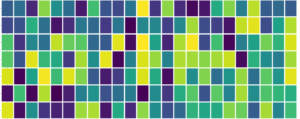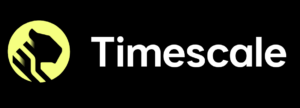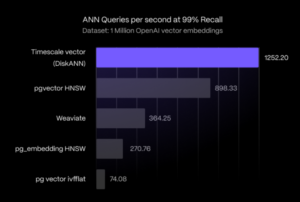

Organizations that are using TimescaleDB to store and query their time-series data may be interested to know that they can use the database to store and query vectors for GenAI applications, too.
Timescale is best known for developing an open source time-series database.. The New York City company added extensions to Postgres to make time-series data a first class data type for IoT type applications, including gaming.
With today’s launch of Timescale Vector, the company is now entering the market for vector databases, which is flourishing as a result of the massive interest in generative AI applications built atop large language models.
Vector databases serve as a sort of long-term memory for LLMs, such as OpenAI’s GPT-4 and Llama from Meta. By storing and indexing the mathematical representations of pieces of text trained by the LLM, dubbed vector embeddings, the vector database can more quickly match the GenAI application’s user input at run time to the most pertinent piece of training data encountered by the LLM.
In TimescaleDB’s case, the company adopted pgvector, the open source vector library for Postgres. In addition to incorporating pgvector, the company bolstered its vector capability by using an Approximate Nearest Neighbor (ANN) algorithm, which it claims gives it much better performance than both plain vanilla pgvector as well as dedicated vector databases.
“We’ve built the additional support for these type of vector lookups that could enable people to build LLM models on top of it to answer … questions in a way that is much more performant, faster, and has better accuracy than other stuff that’s in the market,” says Michael Freedman, the CTO and co-founder of Timescale.
In a lengthy blog post today, the company shared some internal benchmark figures that it says proves its ANN index gives it better, faster performance on a dataset of 1 million OpenAI embeddings than competing vector databases.
The company claims it delivered 243% faster search speed at 99% recall than the vector database from Weaviate. It also claimed that it achieved about 39% faster search speed than pgvector’s ierarchical navigable small world (HNSW) algorithm and 363% faster search speed than pg_embedding.
“Timescale Vector optimizes hybrid time-based vector search, leveraging the automatic time-based partitioning and indexing of Timescale’s hypertables to efficiently find recent embeddings, constrain vector search by a time range or document age, and store and retrieve LLM response and chat history with ease,” the company writes in the blog.
In an interview with Datanami, Freedman also singled out Pinecone, which develops a dedicated vector database, as a new competitor. The problem with dedicated vector databases, Freedman says, is that they only store vector embeddings.
“But often you might have other relational data that you want to use in your question,” he says. “So if you’re building applications on Pinecone, you might need to deploy Pinecone and Postgres and something else, and then bring all that data together at query time and answer questions. If you’re using Timescale, it all sits together in one database, and you could actually build a lot of applications with a much simpler, operationally simpler stack.”
While TimescaleDB is best known as a time-series database, the company has since moved away from that niche and now considers itself to be a general database provider. It can not only store time-series and event data for IoT and gaming applications, but thanks to its Postgres core, it can store any relational data.
“We call ourselves Postgres ++,” Freedman says. “We’re Postgres ‘and.’ We’re not Postgres ‘or.’”
Having that underlying Postgres compatibility gives Timescale the capability to store the data for any organizations that are already using Postgres. That’s a considerable market, considering that Postgres is the world’s most popular database. And that has translated into a considerable amount of success for the open source offering, which counts tens of millions of users, Freedman says. The managed database service that Timescale offers in the cloud has about 1,000 paying customers, he says.
“They’re like, ‘Oh, I already use Postgres. I should just be using you for all of [my workloads],’” Freedman says. “As long as they want a relational database like Postgres, we can become a great go-to for Postgres.”
Timescale introduced its vector support to cloud customers a few months ago and today it’s officially announcing the start of the preview program. The company has attracted several early adopters for its vector capability, including PolyPerception, a European provider of recycling solutions.
“The simplicity and scalability of Timescale Vector’s integrated approach to use Postgres as a time-series and vector database allows a startup like us to bring an AI product to market much faster,” PolyPerception CEO Nicolas Bream says in the Timescale blog. “Choosing TimescaleDB was one of the best technical decisions we made, and we are excited to use Timescale Vector.”
Another early adopter, Blueway Software, is also finding the database a good fit for its GenAI development. “Using Timescale Vector allows us to easily combine PostgreSQL’s classic database features with storage of vector embeddings for Retrieval Augmented Generation (RAG),” says Alexis de Saint Jean, the company’s Innovation Director. “Timescale’s easy-to-use cloud platform and good support keep our team focused on imaging solutions to solve customer pains not on building infrastructure.”
You can learn more at www.timescale.com.
Related Items:
The Human Touch in LLMs and GenAI: Shaping the Future of AI Interaction
TimescaleDB Delivers Another Option for Time-Series Analytics
Home Depot Finds DIY Success with Vector Search
Editor’s note: This article has been corrected. The vector feature is in preview, not general availability. Datanami regrets the error.
June 13, 2025
- PuppyGraph Announces New Native Integration to Support Databricks’ Managed Iceberg Tables
- Striim Announces Neon Serverless Postgres Support
- AMD Advances Open AI Vision with New GPUs, Developer Cloud and Ecosystem Growth
- Databricks Launches Agent Bricks: A New Approach to Building AI Agents
- Basecamp Research Identifies Over 1M New Species to Power Generative Biology
- Informatica Expands Partnership with Databricks as Launch Partner for Managed Iceberg Tables and OLTP Database
- Thales Launches File Activity Monitoring to Strengthen Real-Time Visibility and Control Over Unstructured Data
- Sumo Logic’s New Report Reveals Security Leaders Are Prioritizing AI in New Solutions
June 12, 2025
- Databricks Expands Google Cloud Partnership to Offer Native Access to Gemini AI Models
- Zilliz Releases Milvus 2.6 with Tiered Storage and Int8 Compression to Cut Vector Search Costs
- Databricks and Microsoft Extend Strategic Partnership for Azure Databricks
- ThoughtSpot Unveils DataSpot to Accelerate Agentic Analytics for Every Databricks Customer
- Databricks Eliminates Table Format Lock-in and Adds Capabilities for Business Users with Unity Catalog Advancements
- OpsGuru Signs Strategic Collaboration Agreement with AWS and Expands Services to US
- Databricks Unveils Databricks One: A New Way to Bring AI to Every Corner of the Business
- MinIO Expands Partner Program to Meet AIStor Demand
- Databricks Donates Declarative Pipelines to Apache Spark Open Source Project
June 11, 2025
- What Are Reasoning Models and Why You Should Care
- The GDPR: An Artificial Intelligence Killer?
- Fine-Tuning LLM Performance: How Knowledge Graphs Can Help Avoid Missteps
- It’s Snowflake Vs. Databricks in Dueling Big Data Conferences
- Snowflake Widens Analytics and AI Reach at Summit 25
- Top-Down or Bottom-Up Data Model Design: Which is Best?
- Why Snowflake Bought Crunchy Data
- Inside the Chargeback System That Made Harvard’s Storage Sustainable
- Change to Apache Iceberg Could Streamline Queries, Open Data
- dbt Labs Cranks the Performance Dial with New Fusion Engine
- More Features…
- Mathematica Helps Crack Zodiac Killer’s Code
- It’s Official: Informatica Agrees to Be Bought by Salesforce for $8 Billion
- AI Agents To Drive Scientific Discovery Within a Year, Altman Predicts
- Solidigm Celebrates World’s Largest SSD with ‘122 Day’
- DuckLake Makes a Splash in the Lakehouse Stack – But Can It Break Through?
- The Top Five Data Labeling Firms According to Everest Group
- Who Is AI Inference Pipeline Builder Chalk?
- IBM to Buy DataStax for Database, GenAI Capabilities
- ‘The Relational Model Always Wins,’ RelationalAI CEO Says
- Hex Raises $70M to Power Its Ambition for a Virtuous Cycle of Data Work
- More News In Brief…
- Astronomer Unveils New Capabilities in Astro to Streamline Enterprise Data Orchestration
- Yandex Releases World’s Largest Event Dataset for Advancing Recommender Systems
- Astronomer Introduces Astro Observe to Provide Unified Full-Stack Data Orchestration and Observability
- BigID Reports Majority of Enterprises Lack AI Risk Visibility in 2025
- Gartner Predicts 40% of Generative AI Solutions Will Be Multimodal By 2027
- Databricks Announces Data Intelligence Platform for Communications
- MariaDB Expands Enterprise Platform with Galera Cluster Acquisition
- Databricks Unveils Databricks One: A New Way to Bring AI to Every Corner of the Business
- Databricks Announces 2025 Data + AI Summit Keynote Lineup and Data Intelligence Programming
- FICO Announces New Strategic Collaboration Agreement with AWS
- More This Just In…



























